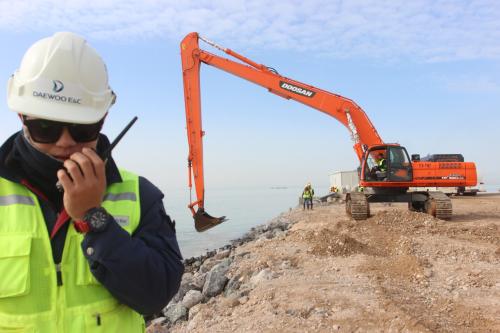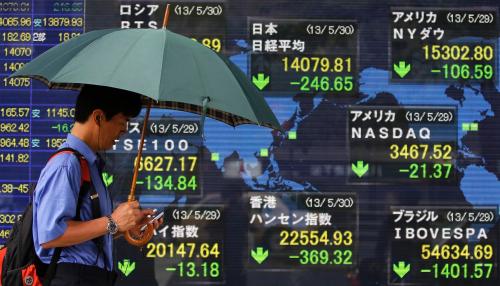For developing countries as a whole, globalization—the process of lowering trade barriers and integrating with the world economy—has been enormously beneficial (Figure 1).
Figure 1: GDP growth rates before and after trade liberalization
Note: Red line=average growth rate before (after) trade liberalization, Blue line=growth rate (3-year MA), Dot=growth rate.
Source: Wacziarg and Horn Welch (2008).
GDP growth rates have been about 2 percentage points higher after trade liberalization. Investment-to-GDP rates have been almost 10 percentage points higher—and sustained for a long time after liberalization. Moreover, this higher growth has contributed to faster poverty reduction in globalizing countries. And there is no systematic relationship between trade liberalization and inequality. In some globalizing countries inequality rose, while in others it fell.
Why then does globalization elicit so much criticism from NGOs and academics, among others? One reason is that the average growth rates hide a huge variation among individual countries. Among major Latin American countries, for instance, the only country that saw a significant increase in its growth rate post-liberalization was Chile; Brazil and Mexico experienced a decline in their growth rates. Similarly, in Africa, with the exception of Ghana, trade liberalization was accompanied by a decline in average growth rates in many countries. It is only in Asia that most countries have seen an increase in growth rates after liberalization. This includes not just the celebrated cases of India and China, but smaller countries such as Bangladesh, Sri Lanka, and the Philippines.
Furthermore, in some of the countries where the growth impact was weak, the employment effects were even more troubling. In Brazil, the regions facing tariff cuts experienced significant drops in formal-sector employment and earnings. These effects became more pronounced 20 years after liberalization.
Finally, for trade liberalization to have its intended effect, a host of other factors have to be in place. Africa still has a huge infrastructure deficit, which means that even if there is trade reform, it remains difficult to ship manufactured goods to ports. India has seen very little growth in manufacturing employment—even though it has a large number of low-skilled workers. The level of education of these people is woefully poor: The share of second-graders in rural public schools who could not read a single word was 80 percent.
Do these criticisms imply that globalization has gone too far? On the contrary, they suggest that it has not gone far enough. For the benefits of trade liberalization were not simply the efficiency gains from removing a set of tariff distortions in the economy. Simulations with computable general equilibrium (CGE) models showed that, if this were the only effect, the benefits from trade reform would be minuscule. Trade restrictions did more than add a distortion to a competitive economy. In many cases, they created domestic monopolies that could exercise their monopoly power behind trade protection. Some of these monopolists were also politically connected, which may explain the resistance to trade liberalization in many countries. When the presence of these monopolies is incorporated into a CGE model, the beneficial effects of trade liberalization become much greater. The reason is that trade liberalization subjects these monopolists to foreign competition, breaking down their monopoly power, lowering domestic prices much more (thereby making it cheaper for those who buy these goods), and permitting the exploitation of economies of scale.
But trade liberalization only affected monopoly power in the tradable sector—manufacturing and agriculture. It did nothing to break down the monopolies in the nontradable sector—services such as finance, transport, and distribution. To this day, the services sector remains largely unreformed. Yet, finance, transport, distribution, and business services are necessary inputs into the production of exports, accounting for about 30-40 percent of value-added in exports. If these nontradable services remain monopolized, then it is difficult for the tradable sector to expand in the wake of trade liberalization.
That this is not just a theoretical possibility, I will illustrate with three specific examples.
- Cronyism in Tunisia. Tunisia undertook major trade reforms in the 1990s but export growth remained anemic. This is surprising given Tunisia’s proximity to Europe, fairly good infrastructure, and an educated population. During this same period, the family of the then President, Ben Ali, had interests in certain enterprises. The sectors where these enterprises were situated received protection from both domestic and foreign competition. And these sectors were telecoms, transport, and banking. So the prices of these services were artificially high (Tunisia had the third-highest telecoms prices in the world). Since you need these services to export, Tunisian exports were not competitive in world markets. The monopoly power enjoyed by these firms can be seen in the distribution of profits: The “Ben Ali firms” relative to the rest of the economy accounted for 0.8 percent of employment, 3 percent of output—and 21 percent of profits.
- Roads in Africa. As already mentioned, Africa’s infrastructure deficit stands in the way of harnessing the gains from trade liberalization. But a study of the major road transport corridors in Africa revealed that vehicle operating costs along these four corridors were no higher than in France. What was higher in Africa were transport prices—the highest in the world, in fact. The difference between transport prices and vehicle operating costs is the profit margin accruing to the trucking companies. These margins were of the order of 100 percent. How can this be? Because there are regulations in the books in almost every African country that prohibit entry into the trucking industry. These regulations were introduced a half-century ago when trucking was thought to be a natural monopoly. Today, there is no need for such regulation, but there are huge trucking monopolies in every country that lobby against deregulation. The fact that relatives of the ruling family own the trucking company doesn’t help. Africa’s high transport prices are due to monopoly power in the (nontradable) transport sector, which is in turn standing in the way of the continent’s benefiting from trade liberalization.
- Teachers in India. How is it that second-graders in rural public schools in India can’t read? For about a quarter of the time, the teacher is absent. How can teachers continue to be absent year in and year out? In India, teachers run the campaigns of the local politicians. If the politician gets elected, he turns around and gives the teacher a job for which he doesn’t need to show up. The result is that teachers, being providers of nontradable services, have a small degree of monopoly power that enables them to be absent without major sanctions.
In sum, the reason trade liberalization has not fully delivered on the promise is that only tradable sectors have been subject to international competition. If this competition can be spread to the nontradable sectors, we will see greater competition in those sectors and bigger gains from trade liberalization. The problem with globalization is not that it has gone too far; it’s that it hasn’t gone far enough.








Commentary
Has globalization gone too far—or not far enough?
September 3, 2019